|
|
Eaton's Winnipeg and Toronto Catalogues Compared
(Page 2)
<< Page 1
Eaton's in Winnipeg
| Marketing to Practical,
Individualistic
Men in the West | Clothing for Cold Weather
| Overalls as Practical,
Patriotic Workwear
| Comfort over Fashion in Women's Clothing
| Larger Sizes in the West
| Stylish or Strong Footwear | Children's Clothing
| Homemade Entertainment | Farm Machinery
| The Imperial Brand | Cream Separators
| Edgerite Tools | Harness | Automobile Supplies|
Conclusion |Further Reading
|
Stylish or Strong Footwear
| |
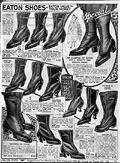 |
|
| |
 Eaton's
(Winnipeg) Fall/Winter Catalogue, 1923-24, p. 155. Eaton's
(Winnipeg) Fall/Winter Catalogue, 1923-24, p. 155.
|
|
| |
|
|
|
The footwear sections of the catalogue were also noticeably different.
The
"Dairymaid" shoe in Toronto was described as "Suitable
for
work in the garden. Lightweight and neat appearance," whereas the
comparable
"Milkmaid" shoe in Winnipeg was recommended "for women
who
are out of doors much; made from light weight split leather, low heels;
very
serviceable." Toronto promoted its boots with phrases such as:
"Relief
for Tender Feet" and "Women's Correct Style
Footwear,"
whereas Winnipeg referred to "Stylish and Serviceable" and
"Women's
Strong Boots for Farm and House." Women were admonished to choose
the right
style of footwear for their needs, and to take care of their boots:
"It
is essential that footwear be used for the purposes for which it is made
if you
want the best results. Don't wear lightweight dress shoes for farm
work;
they are not built for this purpose."
|
Children's Clothing
Children's clothing differed in the two catalogues. In many
cases, the
same goods were available but in different sections of the catalogue. In
particular,
the Winnipeg catalogues of the 1910s and 1920s showed teenaged children at
work,
whereas the Toronto catalogue referred more to school and play clothes.
Girls'
wear was a distinct department in Toronto catalogues, whereas in Winnipeg,
girls'
clothes were mixed in with young children's or with misses. In the
West,
teenagers were considered to be men and women. The Winnipeg catalogue
devoted
more space to boys' overalls and highlighted construction details,
as for
menswear. Toronto also carried a broader selection of children's
shoes
(not surprising, as children often went barefoot on the Prairies).
| |
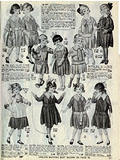 |
|
Eaton's (Winnipeg)
Spring/Summer
Catalogue, 1919, p. 77.
|
 |
|
|
The language used in the catalogues was also different: Toronto
referred to
a child as "active laddie," "merry-looking chap,"
and
"mischief" and the clothes were "moderately
priced,"
"splendid," "sensible," and "very smart and
comfortable."
Winnipeg did not use any fancy adjectives to describe the children but
described
the clothes as "serviceable," "sturdy,"
"strong-wearing,"
and "practical."
|
Homemade Entertainment
| |
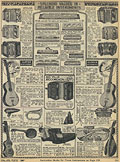 |
|
| |
 Eaton's
(Winnipeg) Fall/Winter Catalogue, 1923-24. Eaton's
(Winnipeg) Fall/Winter Catalogue, 1923-24.
|
|
| |
|
|
|
The Winnipeg edition carried more musical instruments than its Toronto
counterpart.
In 1924, Winnipeg carried more accordions than Toronto by 10 to 5, more
mouth
organs 10 to 6, and violins 7 to 5. In 1926, Winnipeg carried more violins
by
11 to 5, more ukuleles 8 to 6, more guitars 5 to 3, and more accordions 13
to
12. Toronto featured more banjos by 8 to 4 and more mouth organs 17 to 2,
but
Winnipeg featured more expensive models and offered a selection of
orchestra
instruments. This was perhaps a reflection of the greater necessity to
produce
homemade entertainment on the Prairies.
The radio was introduced first in the Toronto catalogue. "Talking
machine"
cabinets were featured in both Toronto and Winnipeg catalogues, but
Toronto's
was more expensive: $175 compared to $75. A selection of radio equipment
was
available through both catalogues in the 1920s.
| |
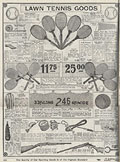 |
|
| |
 Eaton's
(Winnipeg) Spring/Summer Catalogue, 1918. Eaton's
(Winnipeg) Spring/Summer Catalogue, 1918.
|
|
| |
|
|
|
Sporting goods were carried in both catalogues for baseball, football,
hockey,
and basketball. Toronto carried a more extensive range of sporting goods
and
fishing supplies, whereas Winnipeg carried more hunting equipment. Toronto
carried
more canoes and boating supplies, and in the 1930s, a catalogue for
cottagers.
Binoculars, called field glasses in Toronto, were introduced to both
catalogues
in the late 1920s. Comparable selections of cameras and photographic
equipment
were available. The Winnipeg catalogue held photography contests with cash
prizes
of $2, $3, and $5 in the late 1910s to encourage people to send their film
and
plates to Eaton's for processing.
|
Farm Machinery
In the 1910s and 20s, an extensive range of vehicles, farm implements
and
machinery, and tradesmen's tools was available in the Winnipeg
catalogues.
Winnipeg carried more types of goods, more of each type, and more
expensive goods
than did Toronto. By the 1930s, the catalogue carried fewer farm
implements,
a result of the Depression and the limited funds available for major
capital
expenditures. Winnipeg devoted more space in the catalogues to farm items,
frequently
using half- or full-page ads for items that Toronto showed in much smaller
illustrations.
As a result, the Winnipeg catalogues were often noticeably larger than the
Toronto
catalogues.
Toronto carried no farm implements in 1924, whereas Winnipeg carried a
full
range. Farm implements were available in the fall-and-winter catalogues
and a
more extensive line was available in the spring-and-summer catalogues. In
the
late 1910s, Eaton's also produced a special catalogue that included
nearly
100 pages of harness and farm machinery. Mowers, cultivators, harrows,
ploughs,
disc drills, hay rakes, fanning mills, and portable saw frames were all
available.
| |
 |
|
| |
 Eaton's
(Winnipeg) Spring/Summer Catalogue, 1918, p. 480. Eaton's
(Winnipeg) Spring/Summer Catalogue, 1918, p. 480.
|
|
| |
|
|
|
Winnipeg catalogues showed more evidence of self-sufficiency on the
part of
farmers as repair parts and tools were common. In 1910, Winnipeg carried
blacksmith's
forges and a complete blacksmith's outfit, along with a how-to
booklet
on blacksmithing. Winnipeg carried more supplies for leather and wagon
repair
and machine oils and lubricants, as well as a full range of veterinary
equipment
and feed for farmers who cared for their own livestock.
| |
 |
|
| |
 Eaton's (Winnipeg) Spring/Summer Catalogue, 1927, p. 310-11. Eaton's (Winnipeg) Spring/Summer Catalogue, 1927, p. 310-11.
|
|
| |
|
|
|
Beekeeping supplies, including live bees, were available through the
Winnipeg
catalogue, but not from Toronto. In 1927, Winnipeg promoted the business
to farmers:
"Last year Manitoba produced approximately 5,500,000 lbs. [2.5
million
kg] of marketable honey, which was sold at about 13 cents per lb. [per .45
kg.]
Did you receive your share from this easily operated, low cost industry?
If not,
why not get in on this money-making industry — with bees from
EATON's?"
Winnipeg carried two pages of poultry supplies compared to
three-quarters
of a page in the Toronto spring-and-summer catalogues of 1927.
|
The Imperial Brand
| |
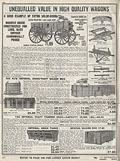 |
|
| |
 Imperial
wagon, Eaton's (Winnipeg) Spring/Summer Catalogue, 1916, p. 360. Imperial
wagon, Eaton's (Winnipeg) Spring/Summer Catalogue, 1916, p. 360.
|
|
| |
|
|
|
Initially, catalogue items were advertised as having been "Made
by a
leading Canadian manufacturer." In the East, Eaton's
distributed
implements under its own name. In the West, after 1909, Eaton's
promoted
the "Imperial" line of farm implements. The Winnipeg catalogue
stated
that "Imperial Implements are Specially Adapted to Western
Conditions":
"Possibly no other article that we catalogue stands out more
prominently
than does the EATON Imperial Wagon for extra good value. A wagon built to
last
not just one season, but a great many seasons." The Imperial big
gang plough
was "The right plow for Western Canada."
| |
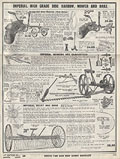 |
|
| |
 Imperial
hay rake, Eaton's (Winnipeg) Spring/Summer Catalogue, 1916,
p. 363. Imperial
hay rake, Eaton's (Winnipeg) Spring/Summer Catalogue, 1916,
p. 363.
|
|
| |
|
|
|
Of the Imperial sulky rake, the catalogue said: "If you have hay
to
rake, whether the crop is light or heavy, there is not a rake sold today
that
will do the work any better than the Imperial Sulky Rake. It can be
operated
by any boy or woman who can drive horses. The automatic foot lift makes
this
very easy."
Eaton's asserted that, "The Imperial Mower is extensively
used
today from Winnipeg to the coast." Of fencing it said: "The
great
demand for Imperial Fencing in Western Canada each season."
Windmills were carried in the Winnipeg catalogues: "the
red-tipped fans
of the 'Imperial' Windmill turning in the breeze as they are
seen
on so many Western farms to-day." Imperial hand pumps were
advertised as
an example of goods being adapted for western conditions: "They are
made
to meet the requirements of the country. Most of them have a set length of
8
feet [2.4 m], that is, the cylinder is 8 feet [2.4 m] below the platform.
This
is done to avoid the frost, and is an important feature, as many pumps
sold in
the West are made for the eastern climate, and their set length is too
short
for our cold Western winters."
|
Cream Separators
| |
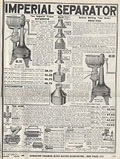 |
|
| |
 Eaton's
(Winnipeg) Spring/Summer Catalogue, 1916, p. 359. Eaton's
(Winnipeg) Spring/Summer Catalogue, 1916, p. 359.
|
|
| |
|
|
|
Cream separators frequently warranted full-page promotions in Winnipeg
and
were consistently more expensive than those offered by Toronto: $58.50 in
Winnipeg
versus $49.50 in Toronto. In the late 1910s, Eaton's referred to the
rapid
increase in dairying in Western Canada due to the wonderful pasture, ease
of
a year-round operation, and continued high prices for milk and butter.
The "Eatonia" cream separator was available through the
Winnipeg
catalogue before changing its name to the "Imperial."
Eaton's
claimed that, "If you purchase an Imperial Cream Separator, it is
only
a matter of time until you increase your herd, because by the use of our
separator,
the work that was previously a drudgery will be made a pleasure."
Toronto
carried the same cream separator under the "Eatonia" brand
name.
The "Vega" cream separator was promoted in the 1930s.
|
Edgerite Tools
| |
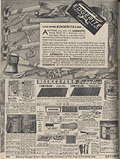 |
|
| |
 Edgerite
tools, Eaton's (Winnipeg) Fall/Winter Catalogue, 1936-37, p. 336. Edgerite
tools, Eaton's (Winnipeg) Fall/Winter Catalogue, 1936-37, p. 336.
|
|
| |
|
|
|
"Edgerite" tools, including lawn mowers, shovels, hay
knives,
and carpentry tools, were promoted in Winnipeg, whereas Toronto carried a
more
limited selection of tools with a variety of manufacturers'
trademarks,
including T. Eaton Co. and Acme, but not Edgerite before 1918.
In the 1920s, Winnipeg continued to carry a larger selection of tools.
Some
tools were available in Winnipeg but not in Toronto. In 1936,
Eaton's claimed
that, "Thousands of Western workmen have learned to depend on
EDGERITE
tools in preference to all others." Toronto promoted the use of
tools for
gardening, as opposed to farm work.
|
Harness
| |
 |
|
| |
 Eaton's
Winnipeg harness shop, from a set of stereoscopic images, ca 1910. Eaton's
Winnipeg harness shop, from a set of stereoscopic images, ca 1910.
|
|
| |
|
|
|
Both catalogues carried harness but the Winnipeg catalogue carried a
more
extensive range, including more expensive harness, and emphasized that the
harness
was western-made for western conditions: "A particular study has
been made
of the Western farmer's requirements." Harness was given
fitting
names like "The Nor'west," "Western Ox,"
"Blue
Ribbon Show Harness," "Western Prairie," "Eaton
Pioneer,"
and "Eaton Economy Team."
| |
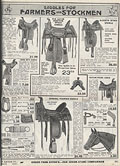 |
|
| |
 Eaton's
(Winnipeg) Spring/Summer Catalogue, 1916, p. 351. Eaton's
(Winnipeg) Spring/Summer Catalogue, 1916, p. 351.
|
|
| |
|
|
|
Winnipeg also carried an extensive selection of horse collars, nose
protectors,
sweat pads, saddles, and horse care items. Saddles, not available through
Toronto
in the 1910s, were marketed under names like "Royal Western,"
"Western
Prairie," "Alberta Stock," and "Pride of the
West."
Some of these goods were manufactured in Eaton's harness factory in
Winnipeg,
while others were purchased for redistribution. The catalogues indicated
that,
"We manufacture these collars; only best quality materials
used."
|
Automobile Supplies
| |
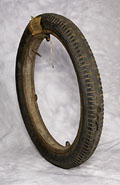 |
|
| |
 Tire
made for Eaton's. Eaton's (Toronto) Spring/Summer Catalogue, 1930,
p. 371. Tire
made for Eaton's. Eaton's (Toronto) Spring/Summer Catalogue, 1930,
p. 371.
|
|
| |
|
|
|
Cars were more of a novelty on the Prairies than in Ontario in the
early 20th
century. Winnipeg suggested using a Ford automobile to power farm
machinery,
grain grinders, hay presses, wood saws, water pumps, well-drilling
outfits, grindstones,
and cream separators, rather than a stationary engine. This must not have
proven
popular because a later advertisement for a "Lay Porta" power
outfit
that required a truck or a car was advertised in Toronto but not shown in
Winnipeg.
Toronto carried a greater selection of auto supplies than did Winnipeg but
both
indicate that this was just a selection. Winnipeg told customers to write
for
a separate booklet, whereas Toronto said, "[S]end us all your
enquiries
for auto accessories." The differences in this area became more
pronounced
over the years as Toronto carried a larger and larger selection of auto
parts.
The 1924 Toronto spring-and-summer catalogue, for example, featured a
full-page
advertisement for tires and devoted five pages to auto supplies, whereas
Winnipeg
only showed one-and-a-half pages.
|
Conclusion
From 1905 to 1940, Eaton's viewed westerners differently than it
did
Ontarians. The company marketed its goods to men as well as to women, and
recognized
the pragmatic nature of its western customers. Rural residents, in
particular,
rarely made it into town, and appreciated the convenience of shopping
through
the catalogues.
| |
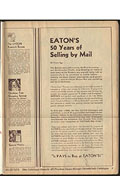 |
|
| |
 Eaton's
(Winnipeg) Fall/Winter Catalogue, 1934-35, p. 3. Eaton's
(Winnipeg) Fall/Winter Catalogue, 1934-35, p. 3.
|
|
| |
|
|
|
The impact of the Eaton's catalogue in the West has been the
subject
of much folklore. Referred to as "The Prairie Bible,"
"The
Farmer's Bible," "The Homesteaders' Bible,"
the
"Wishing Book," or simply, "The Book," the
catalogue
was especially popular in Western Canada. In fact, in the 1920s, two towns
in
Saskatchewan showed their affection for the catalogues by choosing the
names
"Eaton" and "Eatonia" in honour of the company.
On the 50th Anniversary of the mail-order business in 1934, the
Winnipeg catalogue
announced: "The EATON Catalogue is now a Canadian institution in the
West,
as in the East - an essential factor in the West's day-to-day
existence
— supplying merchandise for the Farm, the Home, the Individual
—
all presented under the same EATON guarantee — and all exemplifying
that
now famous slogan — 'It PAYS to Buy at
EATON's!'"
During the Second World War, the country became more urbanized, and the
Winnipeg
and Toronto catalogues became more closely aligned.
|
| |
Further Reading
Cole, Catherine C. "Comparative Analysis of the Toronto and
Winnipeg
Editions of the Eaton's Mail-order Catalogues,
1905-1945."
Unpublished report. Hull: Canadian Museum of Civilization, 1995. Most
research
on Eaton's mail order has focussed on the Toronto catalogues as they
are
readily available on microfilm. Winnipeg editions are available in Western
Canadian
museums.
The Western Development Museum in
Saskatoon
has about 350 Eaton's catalogues, including a large collection
donated
by Eaton's including specialty catalogues for Eaton's houses,
radios,
groceries and plumbing supplies.
The City of Toronto's Culture Division has a collection of 1600
objects
donated by Eaton's, many of which were available through mail order.
The
T.
Eaton Company fonds (F 229) in the Province of Ontario Archives in
Toronto
contains photographs, company literature, catalogue sales and distribution
records,
comparisons between Eaton's and other mail-order companies,
testimonials
and complaints, and information about brands, company organization etc.
|
| |
|
|